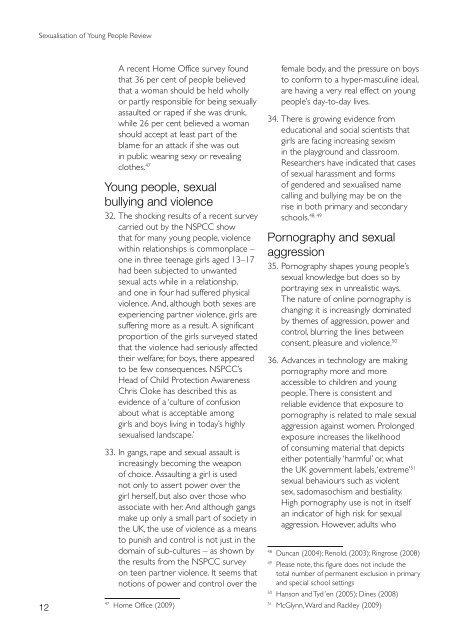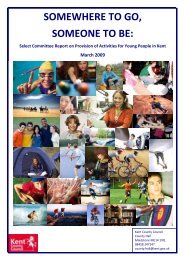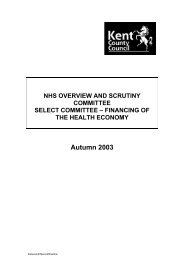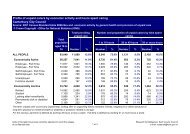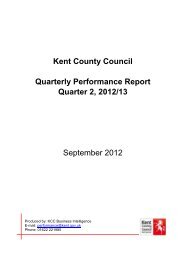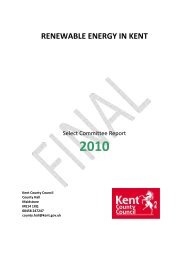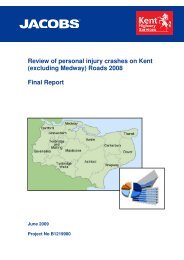Sexualisation of Young People Review
Sexualisation of Young People Review
Sexualisation of Young People Review
Create successful ePaper yourself
Turn your PDF publications into a flip-book with our unique Google optimized e-Paper software.
<strong>Sexualisation</strong> <strong>of</strong> <strong>Young</strong> <strong>People</strong> <strong>Review</strong><br />
12<br />
A recent Home Office survey found<br />
that 36 per cent <strong>of</strong> people believed<br />
that a woman should be held wholly<br />
or partly responsible for being sexually<br />
assaulted or raped if she was drunk,<br />
while 26 per cent believed a woman<br />
should accept at least part <strong>of</strong> the<br />
blame for an attack if she was out<br />
in public wearing sexy or revealing<br />
clothes. 47<br />
<strong>Young</strong> people, sexual<br />
bullying and violence<br />
32. The shocking results <strong>of</strong> a recent survey<br />
carried out by the NSPCC show<br />
that for many young people, violence<br />
within relationships is commonplace –<br />
one in three teenage girls aged 13–17<br />
had been subjected to unwanted<br />
sexual acts while in a relationship,<br />
and one in four had suffered physical<br />
violence. And, although both sexes are<br />
experiencing partner violence, girls are<br />
suffering more as a result. A significant<br />
proportion <strong>of</strong> the girls surveyed stated<br />
that the violence had seriously affected<br />
their welfare; for boys, there appeared<br />
to be few consequences. NSPCC’s<br />
Head <strong>of</strong> Child Protection Awareness<br />
Chris Cloke has described this as<br />
evidence <strong>of</strong> a ‘culture <strong>of</strong> confusion<br />
about what is acceptable among<br />
girls and boys living in today’s highly<br />
sexualised landscape.’<br />
33. In gangs, rape and sexual assault is<br />
increasingly becoming the weapon<br />
<strong>of</strong> choice. Assaulting a girl is used<br />
not only to assert power over the<br />
girl herself, but also over those who<br />
associate with her. And although gangs<br />
make up only a small part <strong>of</strong> society in<br />
the UK, the use <strong>of</strong> violence as a means<br />
to punish and control is not just in the<br />
domain <strong>of</strong> sub-cultures – as shown by<br />
the results from the NSPCC survey<br />
on teen partner violence. It seems that<br />
notions <strong>of</strong> power and control over the<br />
47<br />
Home Office (2009)<br />
female body, and the pressure on boys<br />
to conform to a hyper-masculine ideal,<br />
are having a very real effect on young<br />
people’s day-to-day lives.<br />
34. There is growing evidence from<br />
educational and social scientists that<br />
girls are facing increasing sexism<br />
in the playground and classroom.<br />
Researchers have indicated that cases<br />
<strong>of</strong> sexual harassment and forms<br />
<strong>of</strong> gendered and sexualised name<br />
calling and bullying may be on the<br />
rise in both primary and secondary<br />
48, 49<br />
schools.<br />
Pornography and sexual<br />
aggression<br />
35. Pornography shapes young people’s<br />
sexual knowledge but does so by<br />
portraying sex in unrealistic ways.<br />
The nature <strong>of</strong> online pornography is<br />
changing: it is increasingly dominated<br />
by themes <strong>of</strong> aggression, power and<br />
control, blurring the lines between<br />
consent, pleasure and violence. 50<br />
36. Advances in technology are making<br />
pornography more and more<br />
accessible to children and young<br />
people. There is consistent and<br />
reliable evidence that exposure to<br />
pornography is related to male sexual<br />
aggression against women. Prolonged<br />
exposure increases the likelihood<br />
<strong>of</strong> consuming material that depicts<br />
either potentially ‘harmful’ or, what<br />
the UK government labels, ‘extreme’ 51<br />
sexual behaviours such as violent<br />
sex, sadomasochism and bestiality.<br />
High pornography use is not in itself<br />
an indicator <strong>of</strong> high risk for sexual<br />
aggression. However, adults who<br />
48<br />
Duncan (2004); Renold, (2003); Ringrose (2008)<br />
49<br />
Please note, this figure does not include the<br />
total number <strong>of</strong> permanent exclusion in primary<br />
and special school settings<br />
50<br />
Hanson and Tyd´en (2005); Dines (2008)<br />
51<br />
McGlynn, Ward and Rackley (2009)


